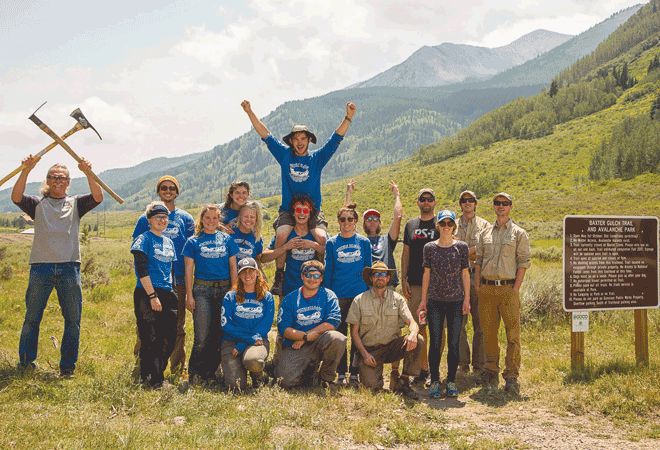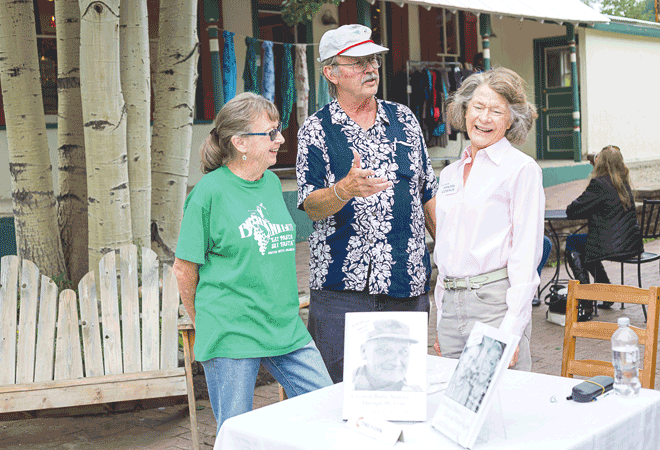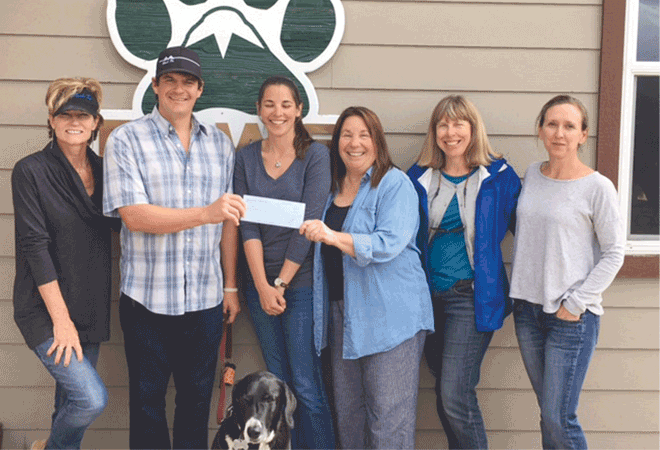by Dawne Belloise
Back in the days of the 1960s, ‘70s and ‘80s, when the legendary potholes of the dirt streets of Crested Butte swallowed spring mud season with a voracious appetite and summer finally rolled out her greenery, long haired, baby-faced locals in bell-bottomed jeans and plaid flannel shirts (worn by both men and women) sat on dilapidated porches strumming guitars and swigging beer.
This week, many of those aging children return to Crested Butte for an accidental reunion of sorts that evolved from a music jam nine years ago when just a few past and present Buttian players got together for a mini-reunion at Kochevar’s to throw down some old tunes.
The several long-time musician friends were sitting on a bench in front of the bar after the gig, reminiscing about the good old days of wily doings and dusty bars in the somewhat feral era of Crested Butte. Squinting in the late afternoon sun that day were players, some of whom hadn’t seen each other in decades. Ramon Burrell, Les Choy, Dawne Belloise, Jim Michael, Tracey Wickland, Flash (Kevin Walsh) and Steve Snyder had all gathered to jam with visiting one-time local Robert J. Conway.
When the music stopped, the discussion immediately turned toward getting back together again and inviting as many performers as possible from the glory days to crank up the notorious Crested Butte Allstars.
Finally, nine years later, Robert J is coming back to town this week, along with an unexpected windfall of former Buttians, far more than only the musicians.
The famed hippies of Crested Butte’s earlier days, after the mines closed down and the railroad tracks were ripped up in the early 1950s, were the new visionaries who actually set the groundwork for what Crested Butte is today—a close, vibrant community with as many aesthetics as there were potholes. But back then, we were so young and certainly not thinking about adulthood. We were focused on hiking and camping, riding our bikes, dancing and partying, and getting enough money together for next season’s ski pass, or as one former local, Paul Andersen, put it, “Miscreants … back in the days of wood, wool and leather…”
The attitudes and reasons for living in Crested Butte haven’t changed that much through the decades—we’re still an outdoor, freedom-loving population playing in the summer mountains while waiting for winter snows. We’re just older now. Those who left to follow a life elsewhere all confess, Crested Butte never leaves you. Those who will be returning for the so-called Crested Butte 40-Year Reunion will find the town changed in many ways, but the essence remains the same.
Remembering the
music with Robert J
Robert J’s Crested Butte history beckons back to the 1970s and his inspiration to gather the clan was concurrent to an anniversary. “It’s been 40 years since I moved to Crested Butte. I moved to Colorado from Detroit with my band, Happy Trails,” he says, recalling the line-up of Jim Michael, Jebediah (Jeb) Bettis, and Morgan Child. “We jumped in a van, lived on the Front Range on a 5,000-acre ranch for a few months, playing in the mountains. Then we moved to El Jebel in 1976 and ‘77, the Winter of Un. We had gigs all set in Snowmass for the whole winter but we got cancelled since there was no snow. Sunshine (of Crested Butte’s much loved Sunshine’s Bathhouse) was booking us and got us a gig at the Tailings (now the downstairs of Secret Stash). We fell in love with the town when we played here. We thought it was the coolest place ever.” The band unanimously agreed to move to town in the spring of 1977.
He went on, “We had a school bus by then and came over Kebler Pass road, having to do about a 100-point turn going into what was then a narrow wooden bridge. We morphed into another band, Northern Dancer, which was all the same guys in Happy Trails. But we added Michael Plant as our sound man, who also sang some country songs, and David Alexander, another Detroit guy who had moved to Colorado. About a month after living here, we found out that molybdenum had been discovered in Mt. Emmons, the Red Lady, and that’s when I wrote the song, ‘Moly Be Damned’ with Tracey Wickland’s ‘Mountain Song’ on the flip side of a 45-rpm record.”
Later bands would include High Altitude Cooking with Mike Farhlander, Papa J, The Crows, and Stray Dogs Blues Band.
Robert J recalls that his favorite place was above Penelope’s (where Ryce is now), up the stairs by Coal Creek. “It was like the inside of a boat with paisley wallpaper, very Victorian, with neat loft above. I was amazed at this little town because as small as it was, there were two newspapers and a radio station. Most of us had fabulous stories about living here. We were burnt out on city life and came to this little beautiful town and it was filled with all these characters. I just loved it. I can’t pinpoint one thing,” he says of what he loved about the town in those days, but it’s stuck with him for decades.
“The whole experience of living in the mountains, at 9,000 feet elevation in paradise, skiing in the winter, trout fishing in the summer, playing music and enjoying life. I have wonderful memories of my life here and I think once you experience that, at that young of an age, it stays in your heart.” Although he left after several years in Crested Butte to move to Wisconsin, he still considers Crested Butte home after all the years away.
Escaping the rest of the world for home
There are many facets explaining the extraordinary endearment and attachment to town that both former and current locals of Crested Butte have. Their sense of place is fortified by strong communal principles. When the hippies and skiers first discovered Crested Butte in the 1960s and ‘70s, the world itself was different and it was a more tumultuous era of societal upheaval. We, as youth, were seeing the world through new eyes and bringing innovative concepts. Here, in the extremes, there were survival elements that transcended differences. People were kind. There was camaraderie, a strong bonding through common ideals. There was also the boasted weirdness and wildness—escalated, honed, and recited in stories down through the years.
Allen Beck didn’t move too far down the road when he left Crested Butte. He’s in Montrose now but he won’t be able to make it to the reunion. “I regret this for several reasons, not the least of which is that I lived there for 20 years and thought I (we) would never leave,” he writes. “Nowhere I had lived before seemed as much a part of me and every time I came back down that last little hill into town, I felt I was coming home once more. I moved there in 1988, just in time to win the Liar’s Contest for newcomers at Kochevar’s for Vinotok and met Marcie [Telander] that week. I was hooked on story-telling from that week and still am, although I don’t have to make up as many new ones as I did for a long time. We moved due to a need to make a decent living but as I said above, never thought of that happening until it did.”
Jim Schmidt, aka Deli, arrived on the Crested Butte scene in 1976, seeking something more than the rat-race in suburban Chicago. “I’d been out of college for six years,” he says of his decision to bolt the Midwest, “so I quit my job, jumped on my motorcycle and took off for three months, riding all over the West, hitting every national park I could find. Some friends had moved to Crested Butte, which I had never heard of. They had bought an empty building, which is now the Talk of the Town.”
Deli says the upstairs had an unadorned apartment, as empty as the downstairs, but the bath was functional with a shower and he had been camping for months. “My first week in Crested Butte, I slept upstairs without even a chair in the room. The town and its people felt a lot like college to me because so many of them were the same age and there was a lot of partying going on. I was looking for a place to move to, and the words of John Denver’ Rocky Mountain High, ‘coming home to a place he’d never been before,’ struck a chord,” and, he says, “It just felt right.”
Deli wasn’t a skier, having gone down the slopes only twice in his life, so that wasn’t a motivation to move here, although, because he was pretty much a jock, he figured he could learn the sport. In the summer of ‘78 Deli headed out to Lake Nicholson with a friend to swim, where bathing suits were not the norm. “Here I was, this naïve Midwestern boy who was not used to naked people and there were about 80 buck-naked people out there. It was eye-opening to say the least,” he laughs. Working at the Crested Butte Sandwich Company in the Emmons Building on the mountain is how Jim got his moniker. “I did a radio commercial for the sandwich shop and in the background Lynda and Bonnie Petito were singing ‘Jim Deli to the Rescue’ and that stuck.” He’s been Jim Deli forever more.
Social media alert
Ever since a Facebook page was put up announcing a Crested Butte 40th Reunion, the response has been overwhelming. There are 1,400 people logged in to the page and at least 500 confirmed Buttians flying, driving or crawling their way back from all corners of the country, back to their memories and former lives in town.
There are photos of ski passes and Western State College IDs, band set lists and menus from restaurants we loved. Recollections of softball teams, bar scenes and holiday gatherings in drafty rustic houses are recounted. There are grinning mustachioed faces bumping down Resurrection on impossibly long skis, and way more free heelers than you see on the mountain these days. Beloved long-gone dogs.
Deli reminisces, “I’ve looked at a lot of those photos and I think, what a bunch of young, happy, healthy people. I remember the good times more than the bad times.” The bad times being how money was extremely tight. “The work wasn’t there. The off seasons were really dead. Summer was like May is now.”
Summer is now busier than winters, because back then there was nothing going on in the summer, and Deli feels, “People didn’t realize how beautiful it was here.” He also notes that the climate has changed profoundly. “When I got here there were only two seasons, winter and the Fourth of July, and it snowed a few times on the Fourth but in May and September you could count on snow being on the ground. I remember playing softball with ski gloves on as we were wrapping up the season at the end of August. It was cold.”
Endless opportunity
Crested Butte was a community that enabled its residents to do anything, whether it was to act in a play, become a deejay or write for the newspaper. Deli says, “It gave you the opportunity to teach yourself. Nobody ever said, you can’t do that and the people were just so welcoming that they accepted you for whatever you wanted to do.”
In a close-knit community that was oftentimes isolated and insulated from the outside world, you depend on each other. Deli says he’ll be wearing a special nametag to the reunion that will read, “Hello my name is Jim Deli Schmidt. I can’t remember your name or if I slept with you or not.”
Of the Baby Boomer generation that came of age in those Crested Butte days, many have stayed, some have gone and returned and some are gone forever. Deli plans on never leaving. He bought a gravesite for $50 in the town’s cemetery that holds seven full-size coffins or tons of your best friends’ ashes. Since he never married or had a family he’s offering those extra spaces to his friends and urges, “Sign up now, I’ll be quiet,” he promises of grave-mate eternity in paradise.
There’s a trio of women who arrived in town in 1978 who are well known and loved as the Flying Petito Sisters. Lynda Petito arrived first and ecstatically urged her sister Bonnie to get herself out here. “Bonnie, you’ve got to check this place out. It’s like we won the revolution,” she told her sister. It pretty much summed up Crested Butte in one sentence. Bonnie and their youngest sister, Cindy, followed within six months.
“The town felt much smaller. It was quiet and dusty and if anything was happening, everyone seemed to know about it,” Bonnie said fondly of her home of almost 40 years now. “We all seemed to be on the same page, with the same life references and similar educations and experiences. It’s hard to imagine now because summers are so busy, but the first few years I lived here, summers were pretty dead. If there were cars parked on Elk Avenue then you’d scratch your head and try to remember what was going on. It’s the people and my family that so far have kept me here. I wish we could find another spot, in a warm climate, where we could all relocate for our golden years. I would miss this place but if I were surrounded by my Crested Butte friends it would be okay.”
We may have gotten older, but we’ve never lost the joy of having lived in such a magical place, and like Peter Pan, those who once experienced living here never lose their love of Crested Butte or the inner child that it nurtures.
Robert J, the Crested Butte Allstars, and Darkstar will play the Eldo, Friday, July 28 from 4 to around 8 p.m.








 The Crested Butte News Serving the Gunnison Valley since 1999
The Crested Butte News Serving the Gunnison Valley since 1999

